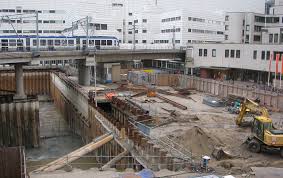The Importance of Infrastructure in Modern Society
Infrastructure plays a crucial role in the functioning of modern society. It encompasses the fundamental physical and organizational structures, facilities, and systems needed for the operation of a society or enterprise.
Transportation infrastructure, such as roads, bridges, and public transportation systems, enables the movement of people and goods efficiently. Without well-maintained roads and bridges, commuting would be chaotic and economic activities would be severely hindered.
Similarly, energy infrastructure, including power plants and electrical grids, ensures that homes and businesses have access to electricity for lighting, heating, and running appliances. A reliable energy supply is essential for economic development and quality of life.
Communication infrastructure, such as internet networks and telecommunications systems, connects people across the globe. In today’s digital age, access to high-speed internet is vital for education, business operations, and staying connected with loved ones.
Water and sanitation infrastructure provide clean drinking water and proper waste management services to communities. Access to clean water is a basic human right that is essential for public health and well-being.
Overall, investing in infrastructure is crucial for economic growth, social development, and environmental sustainability. Governments and private sector entities must work together to plan, develop, maintain, and upgrade infrastructure to meet the evolving needs of society.
By prioritizing infrastructure projects and ensuring their long-term sustainability, we can create a more resilient and prosperous future for all.
9 Essential Tips for Enhancing and Sustaining Infrastructure
- Regular maintenance is key to prolonging infrastructure lifespan.
- Invest in sustainable materials for future-proof construction.
- Incorporate smart technology for efficient infrastructure management.
- Ensure robust planning to accommodate future growth and demand.
- Prioritise safety standards in all infrastructure projects.
- Engage with local communities for feedback and support.
- Diversify funding sources to enhance project viability.
- Focus on resilience to withstand environmental changes and disasters.
- Streamline regulatory processes to expedite project approvals.
Regular maintenance is key to prolonging infrastructure lifespan.
Regular maintenance is essential for prolonging the lifespan of infrastructure. By conducting routine inspections, repairs, and upgrades, infrastructure assets can remain in optimal condition and continue to function effectively for years to come. Neglecting maintenance can lead to deterioration and costly repairs down the line, impacting the safety and reliability of essential systems such as roads, bridges, utilities, and buildings. Investing in proactive maintenance practices is a wise strategy to ensure the longevity and performance of critical infrastructure components.
Invest in sustainable materials for future-proof construction.
Investing in sustainable materials for future-proof construction is a strategic decision that not only benefits the environment but also ensures the longevity and resilience of infrastructure projects. By choosing materials that are eco-friendly and durable, construction projects can reduce their carbon footprint and contribute to a more sustainable future. Sustainable materials also have the potential to lower maintenance costs over time, making them a cost-effective choice in the long run. Prioritising sustainability in construction practices is essential for building infrastructure that can withstand the test of time while minimising environmental impact.
Incorporate smart technology for efficient infrastructure management.
Incorporating smart technology for efficient infrastructure management is a strategic approach that leverages advanced digital solutions to enhance the monitoring, maintenance, and performance of critical systems. By integrating sensors, data analytics, and automation tools into infrastructure operations, organisations can proactively identify issues, streamline maintenance processes, and optimise resource allocation. This not only improves operational efficiency but also reduces downtime, enhances safety measures, and ultimately leads to cost savings in the long run. Embracing smart technology in infrastructure management paves the way for a more sustainable and resilient built environment that can better serve the needs of society.
Ensure robust planning to accommodate future growth and demand.
Ensuring robust planning to accommodate future growth and demand is essential when developing infrastructure. By anticipating the needs of a growing population and evolving technologies, infrastructure projects can be designed to be scalable and adaptable. This proactive approach not only prevents bottlenecks and inefficiencies in the future but also ensures that the infrastructure investments made today will continue to meet the demands of tomorrow. Planning for future growth enables sustainable development and allows for smoother transitions as communities expand and technology advances.
Prioritise safety standards in all infrastructure projects.
It is paramount to prioritise safety standards in all infrastructure projects to ensure the well-being and security of individuals using these facilities. By adhering to rigorous safety protocols and regulations, we can mitigate risks, prevent accidents, and create a secure environment for both workers and the public. Emphasising safety in infrastructure development not only safeguards lives but also instils confidence in the reliability and longevity of the built structures, fostering a sustainable and resilient society for generations to come.
Engage with local communities for feedback and support.
Engaging with local communities for feedback and support is a crucial tip when it comes to developing infrastructure projects. By involving the residents and stakeholders in the planning process, project developers can gain valuable insights into the specific needs and concerns of the community. This collaborative approach not only fosters transparency and trust but also ensures that the infrastructure projects are well-received and supported by those who will be directly impacted. Ultimately, listening to and involving local communities leads to more sustainable and successful infrastructure developments that benefit everyone involved.
Diversify funding sources to enhance project viability.
Diversifying funding sources is a strategic approach that can significantly enhance the viability of infrastructure projects. By seeking financial support from a variety of sources, such as government grants, private investments, and public-private partnerships, project developers can reduce risks and increase the likelihood of securing necessary funding. This approach not only spreads the financial burden but also brings in different perspectives and expertise, ultimately contributing to the overall success and sustainability of infrastructure initiatives.
Focus on resilience to withstand environmental changes and disasters.
In the realm of infrastructure development, a key tip is to prioritise resilience in order to withstand environmental changes and disasters. By incorporating robust design elements and strategic planning that anticipate and mitigate potential risks, infrastructure can better endure the challenges posed by natural disasters, climate change, and other environmental factors. Resilient infrastructure not only safeguards communities and businesses from disruptions but also ensures continuity of essential services, fostering sustainability and long-term prosperity.
Streamline regulatory processes to expedite project approvals.
Streamlining regulatory processes is a key tip to expedite project approvals in infrastructure development. By simplifying and standardising the approval procedures, stakeholders can navigate the regulatory landscape more efficiently, reducing delays and uncertainties. This approach not only accelerates project timelines but also fosters a conducive environment for investment and innovation in infrastructure projects. Embracing streamlined regulatory processes can lead to increased productivity, cost savings, and ultimately, the timely delivery of essential infrastructure that benefits society as a whole.
Tags: communication, economic growth, efficient management, energy, environmental sustainability, future-proof construction, importance, infrastructure, lifespan, maintenance, modern society, sanitation, smart technology, social development, sustainable materials, transportation, water
